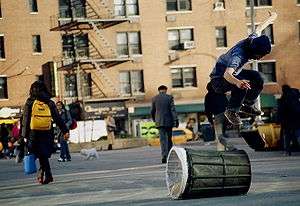Street skateboarding

Street skateboarding is a style of skateboarding that focuses on tricks and transitions in public places. Street skateboarders skate in urban streets, plazas or industrial areas, making use of park benches and picnic tables, guard rails and handrails, planter boxes, bins, stairs, retaining walls and other street furniture not purpose-built for skateboarding.[1]
Competition street skateboarding is conducted in purpose-built skateparks designed to replicate real-world urban environments featuring purpose built benches, stairs and rails alongside traditional skatepark elements like vert ramps and funboxes.
History
As skateboarding gained popularity during the 1980s and 1990s, skateboarders no longer limited their activities to drained swimming pools and purpose-built skateparks. Instead, they began performing tricks in urban areas and skating through urban areas as skateboards increasingly became an accepted mode of transportation as others followed. Traversal through urban areas evolved to where some skateboarders began focusing on skating in and around those urban areas; honing their skills by skating improvised courses made up of existing urban features.[2]
Interaction with general public

Given street skateboarding makes use of urban environments and public areas, it is the style of skateboarding that most often brings skaters into contact with the public, law enforcement, and other authorities.[3] In some cases, local authorities in popular skateboarding areas have introduced a range of initiatives to ban skateboarding, confiscate skateboards, or make skateboarding difficult or impossible.[4]
Competitions
A number of major international competitions include a street skateboarding event or component, including:
Technical set up
Skateboarders usually set up their boards with 48mm to 55mm wheels and narrower decks to make the board flip and spin faster and to make performing tricks easier. Most boards are about 7 1⁄4 to 8 3⁄4 inches (180 to 220 mm) wide and 30 to 32.5 inches (760 to 830 mm) long. The wheels are made of an extremely hard polyurethane, with hardness (durometer) anywhere from 80A to 99A. Some wheels will be made harder than measurable on the "A" scale and will have durometers of up to 84B (about 104A). The wheel sizes are relatively small so that the boards are lighter, and the wheel's inertia is overcome quicker, thus making tricks more manageable. Board styles have changed dramatically since the 1970s but have remained mostly alike since the mid-1990s. The contemporary shape of the skateboard is derived from the freestyle boards of the 1980s with a largely symmetrical shape and relatively narrow width. This form had become standard by the mid 1990s.[5][6][7] Parts can be individually replaced and fixed should they require maintenance.[8]
References
- ↑ Foster, Philip (29 April 2012). "Different Kinds of Skateboarding". LiveStrong. Retrieved 6 April 2013.
- ↑ Goodfellow, Evan; Werner, Doug (1 June 2005). Street Skateboarding: Endless Grinds and Slides. Tracks Publishing.
- ↑ Fleming, Robin (18 June 2012). "Skills to Pay the Bills". ESPN X Games. Retrieved 6 April 2013.
- ↑ "Skateboarders unfairly labeled". Martinsville Bulletin. 4 February 2013. Retrieved 6 April 2013.
- ↑ "Freestyle". Skateboard Express. Retrieved 6 April 2013.
- ↑ "How Boards Have Changed Over Time". Exploratorium. Retrieved 6 April 2013.
- ↑ "Skateboard Guide and Skate Size Chart". evo. Retrieved 6 April 2013.
- ↑ "Maintenance Guide". Vault Skate. Retrieved 6 April 2013.